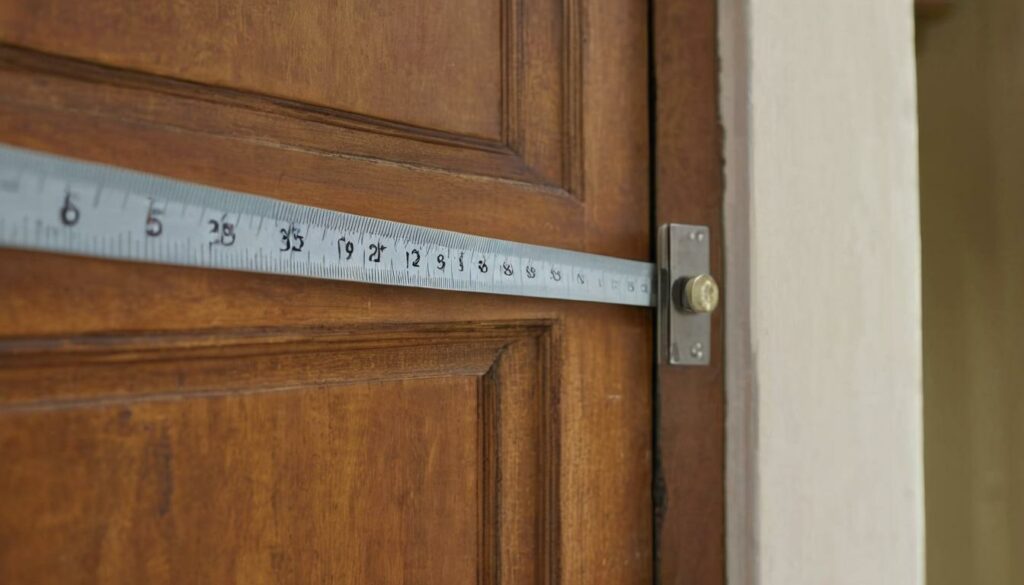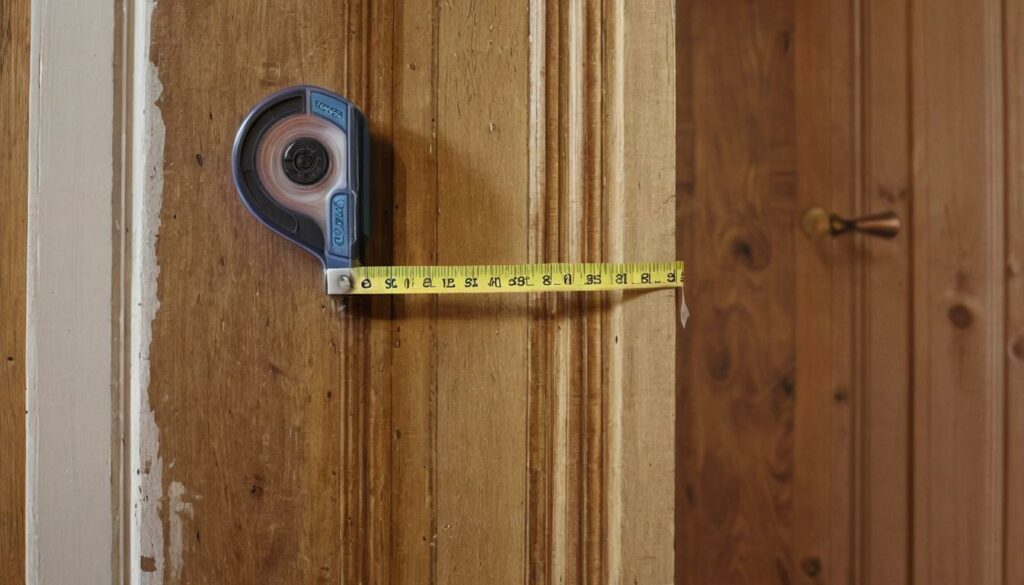Measuring doors for installation may seem straightforward at first glance, but it’s an intricate process where precision is paramount. A slight miscalculation can lead to ill-fitting doors and additional expenses, adding stress to your home improvement project. By carefully following a series of detailed steps, you can ensure a perfect fit every time.
Before you even start measuring, preparing the workspace by removing any obstructions and clearing out debris is essential. Once ready, taking down the old door helps get a clear picture of the frame’s condition. This preparation phase sets the stage for accurate measurements and smooth installation ahead.
To measure doors for installation, first, measure the width of the door frame at the top, middle, and bottom to find the narrowest point; use the shortest measurement. Then, measure the height from the floor to the top of the frame on both sides to ensure accuracy, and note any obstructions that may affect the fit.

Preparing to Measure Your Doors
Clearing the area around the door is essential; you’ll want a clean and uncluttered space that allows you to move freely while taking measurements. Any obstacles in the vicinity can lead to distractions or errors in your measurements. Ensure there’s enough room to work with tools, especially if you’re using a large tape measure or level. This will help maintain accuracy and make the overall process smoother.
Remove the Old Door
Once you’ve got the space ready, it’s time to remove the old door if there’s one in place. Start by carefully taking off the hinges with a screwdriver. If you’re planning on reusing the hardware, set them aside in a safe location where they’re easy to find later. Labeling bags or containers can make reassembly easier since everything will be organized.
With the old door out of the way, you’re now on to a critical step: inspecting the frame.
Inspect the Door Frame
Now, take a moment to closely examine the door frame itself. Look for any signs of rot, warping, or damage that could hinder not just your new door’s installation but also its future usability. For instance, unevenness or damage could affect how well your new door fits. Running your hands along the surface; a rough feel could mean it’s time for repairs.
Addressing these issues beforehand is smart and essential for ensuring long-term functionality. Painting over a rotten area won’t fix it; it may just hide the problem temporarily until it surfaces again. Consider filling gaps or uneven spots with appropriate fillers or making necessary structural repairs under your watchful eye.
Taking these preparatory steps might seem tedious, but they lay a solid foundation for successful measuring and hassle-free installation. Ensuring that everything in your workspace is ready will enhance both efficiency and effectiveness as you proceed in this home improvement project.
This attention to detail paves the way for gathering what you’ll need next, as we transition into specifics about materials that are essential for moving forward effectively.
Assembling Necessary Tools
The right tools can make all the difference when it comes to measuring doors. Let’s discuss each item on our list, as well as why it’s essential for ensuring precision in your measurements.
The tape measure is perhaps the most fundamental tool you need. I recommend using one with a lock feature; this not only prevents it from retracting unexpectedly but also allows you to hold the measurement firmly in place. It’s worth investing in a durable model that offers both metric and imperial measurements, so you can easily switch between systems if needed. Imagine struggling to line up a measurement reading while fumbling with a tape that keeps rolling back—frustrating, right?
Next up is the carpenter’s level, which ensures that your measurements are accurate both in height and plumb.
When mounting a door, it’s crucial for it to hang straight. A carpenter’s level helps you confirm that every measurement relates correctly to gravity, avoiding any potentially costly mistakes later on. It can be useful not just when installing, but also when checking existing installations to see if they have shifted over time.
Now let’s turn our attention to the small yet mighty items: notepad and pencil.
Jotting down your measurements immediately is vital since human memory can be surprisingly unreliable, especially on busy project days. A small notebook can be invaluable here. In my experience, writing everything down as you go reduces errors. Moreover, once you have several door frames in mind, noting which room each door belongs to will save you a headache during installation.
Moving forward, a screwdriver should not be overlooked either.
While this tool might seem standard, it’s important for removing old hinges or adjusting hardware if necessary during your measuring process. Opt for one with interchangeable heads; this versatility will save space and provide convenience throughout your project.
If the door frame is elevated or if you’re working in tight spaces, having a ladder is critical for safety.
Elevating yourself gives you access to top corners and upper frame measurements that are often overlooked. A sturdy step ladder will allow you to manage heights without stretching awkwardly or leaning precariously.
Finally, we can’t forget about the square ruler.
This tool might appear simplistic, but its role is pivotal in checking for right angles within the door frame. Ensuring that corners are square can dictate how well your new door fits into its frame—and no one wants a misaligned door that sticks or doesn’t close properly. A quick check with a square ruler before finalizing measurements will help avoid potential pitfalls down the road.
With all these essential tools at your disposal, you’re ready to move forward confidently. Each item plays a crucial role in preparing for an accurate measurement process.
Measuring Door Widths

Accurate width measurement is essential because it ensures your new door fits perfectly within the frame. To begin measuring, the first step involves determining the width at the top of the door frame. Stretch your tape measure from one side to the other edge at the top. It’s crucial to ensure that the tape measure is level; any angle could yield an incorrect reading. Once you have that measurement noted, you can move down to take another measurement.
The process of measuring does not end at the top; we need to check multiple points on the frame for a more accurate result.
Step I – Measure the Top
Start with the top edge. With your tape measure laid flat and straight, note that width down—not just for thoroughness but to help track any discrepancies later on.
Now that we have finished estimating the width at the top, let’s proceed to get measurements in the middle section of the door frame.
Step II – Measure the Middle
Repeat this same process in the middle section of the door frame. It’s vital to ensure that your tape measure remains straight; bending or positioning it at an angle can lead to inaccurate readings. Double-check your placement before noting this measurement as well—it can save you from potential headaches later on.
Having completed our middle measurement, we’re now ready to check our final point, which will give us our last data point for this crucial width measurement.
Step III – Measure the Bottom
For the final step, measure at the bottom of the door frame in exactly the same manner. Laying down your tape measure horizontally across this spot allows you to get that necessary dimension down correctly. At this point, you’ll have three width measurements: top, middle, and bottom.
The next logical step is determining which measurement you will use for selecting your new door’s width.
Choosing the Right Width
When it comes time to select your new door width, always opt for the longest of your three measurements. This precaution accounts for any irregularities in your door frame; using a shorter measurement could lead to a poor fit and subsequent gaps or misalignments when you install your new door. Taking these extra steps may seem tedious, but they are essential for ensuring a perfect fit and avoiding issues down the line.
With these insights, you’re equipped to approach your measurements confidently before diving deeper into height considerations and their significance in successful installations.
Measuring Door Heights
Height measurement might seem straightforward but requires careful attention. The first step in this process is to measure from the floor to the top. Begin by placing the end of your tape measure at the highest point of the door threshold and running it up to the top of the door frame. It’s crucial to be accurate here since any miscalculation can lead to installation issues later on. Remember to pull the tape taut without bending it, as this ensures you capture the true vertical distance.
Watch for floor discrepancies as you measure.
Step I – Measure from the Floor to the Top
When you commence your measurement, ensure that you’re aligned with the straight edge of the threshold. If your floor has any uneven spots or slopes—more common than you might think—this could lead to inaccuracies. A proper measurement helps your new door fit seamlessly into its frame and plays a vital role in maintaining energy efficiency and aesthetics within your home.
As you’ve measured one part, it’s now essential to verify consistency across different locations.
Step II – Verify Consistency
Next, check several spots along the bottom of the door frame to ensure consistency in height. This involves moving your tape measure and checking both sides and the center of the doorway. Floors can sometimes be uneven enough to go unnoticed until it’s too late. Take note of the shortest measurement you find during these checks; this will be your final height for installation purposes.
By adhering to these steps diligently, you will ensure that your door fits perfectly and set a foundation for smoother operation and longevity. A level entrance contributes significantly to home value and accessibility as well.
Having established a reliable measurement for door heights, let’s move forward to evaluate how much space surrounds your door frame, ensuring an ideal fit and function.
Assessing Frame Space

The assessment of frame space, often referred to as the rough opening, is a critical step in ensuring that your new door fits properly. A well-measured rough opening prevents various installation headaches down the road. It’s not merely about fitting a door into an opening; it’s about creating a functional and secure barrier to the elements and securing your home’s safety.
To start measuring your rough opening, make sure to measure at three different points: the top, middle, and bottom of the opening. This accounts for any irregularities that may exist in your walls or framing. By filling out a table like this during your measurement process, you can visualize any discrepancies that may require adjustments before installation.
| Measurement Point | Width (inches) | Height (inches) |
| Top | ||
| Middle | ||
| Bottom |
During this assessment, it’s essential to pay close attention to clearance around the door frame. Always add an extra 2 to 3 inches for widths and 1 to 2 inches for height when considering the actual dimensions of the door. This extra space allows for the door frame and shimming—both critical for achieving a level and plumb installation.
Shims provide the support necessary for stabilizing the door within its frame so that it operates smoothly over time without warping or sticking. Using shims will also help align everything perfectly, making future adjustments easier if needed.
Taking care to address these aspects now means you’re less likely to face issues later on, such as misaligned doors or gaps that let drafts in—problems that can be costly in both repairs and energy efficiency.
With your rough opening accurately assessed, you’ll have a solid foundation for effective installation. Next, we will focus on selecting the appropriate materials and styles that harmonize with those dimensions you’ve gathered.
Measuring for Door Hardware
When it comes to installing your new door, ensuring that all hardware components are placed correctly is key to functionality and aesthetics. Proper measurements can prevent frustrating adjustments down the line, facilitating a smooth installation process. The two main components you will need to measure for are the lockset and the hinges, each playing a pivotal role in how well the door operates.
Step I – Measure for Lockset
Measuring for the lockset is essential because its position directly impacts usability and security. Start by measuring the distance from the top of the door frame down to where you’d like your lock to be positioned. A common standard height is around 36 inches from the bottom of the door, but this can vary based on personal preference or specific needs such as accessibility requirements.
Make sure you mark this point clearly before proceeding.
It’s always a good idea to double-check this measurement against any existing doors to ensure consistency throughout your home or project. Additionally, remember to consider how you want your lock mechanism to function; some may prefer different heights depending on ease of access.
Step II – Measure for Hinges
Next up are the hinges, which are just as important as the lockset when it comes to proper alignment and function. To accurately measure for hinges, start by examining the positions of any existing hinges on both your old door and the door frame. Typically, most doors utilize two or three hinges, depending on their size and weight.
- Identify Existing Positions: Measure from the top of the door frame down to where each hinge sits on your current setup.
- Check Measurements: Compare these figures with those on your new door; consistency is critical here. Ensure that these measurements are identical to avoid fitting issues once your new door is brought into place.
Once you’ve documented these distances, it’s best practice to transfer them onto your new door using a level or square to ensure everything is perfectly aligned at installation. A well-placed hinge ensures smoother operation and prolongs the life of both your door and its hardware.
With accurate measurements in hand, you can lay a strong groundwork for effective installation techniques that enhance both performance and durability. Let’s now explore some superior techniques that lead to achieving precise measurements seamlessly.
Best Practices for Accurate Measurements
Achieving precise measurements is not just about having tools at hand but also about mastering the technique. First, make sure you have the right equipment. A sturdy tape measure is essential, but consider investing in a digital one for added precision. These tools often have features like automatic locking and error detection, which can significantly simplify your task.
When you approach measuring your doors, remember that every small detail counts.
Double-check every measurement you take. Before walking away from your measuring spot, take a moment to look over your results and ensure they make sense. Sometimes, numbers can play tricks; they may appear correct only to reveal errors after further inspection. This is why I always advise people to write down their findings in a notebook or on a digital device, keeping each measurement clearly noted with the corresponding part of the door it refers to.
Always measure twice to avoid mistakes. Rushing through this simple step can lead to miscalculations that could cost you time and possibly money if replacements are necessary. Make it a habit to have someone assist you during the measuring process, especially if you are working alone. Having an extra set of hands allows for someone to hold the tape measure steady while you read the scale, ensuring more accurate readings.
Using a digital tape measure can increase accuracy, as I mentioned earlier, but traditional tape measures are perfectly capable if handled correctly. When using them, ensure that the end of the tape is flush against the edge where you’re starting—any gap can throw off your numbers by fractions of inches that add up with larger dimensions.
Consistency is key; therefore, each step must be diligently followed. Ensure you take measurements at various points—the top, middle, and bottom of the door frame—to account for any irregularities in walls or alignment issues. Often homes settle over time, causing frames to warp slightly, which can be a nuisance when installing new doors.
Lastly, don’t forget about context; always account for the type of door you plan to install. Different styles—like sliding barn doors versus hinged ones—will require additional space considerations both in height and width due to their mechanisms. By being thorough and attentive to these details, you’re setting yourself up for a successful installation with minimal headaches along the way.
As we move forward, it’s essential to consider how these measurements translate into the overall fit and installation process for your new door. Understanding this next phase will ensure everything aligns perfectly in your project.
Ensuring Proper Fit and Installation
The journey to a successful door installation starts with dry fitting the door. This is where you place the new door in the frame without finalizing any fixtures or locking it in place. It’s a crucial step; by doing this, you can visually inspect how well the door fits within the frame and check for any unevenness.
If you notice that the door is too tight in one area or doesn’t align properly at the top or bottom, now’s the time to make those minor adjustments. A little tweaking of the frame can prevent bigger issues down the line, ensuring the new door swings freely without catching or rubbing.
Once you’re satisfied with the fit, it’s time to secure the door firmly into place.
Step II – Install with Precision
Now comes the all-important installation process. You’ll want to attach the hinges and other hardware carefully. A common oversight is rushing through this part after achieving a decent fit, but taking your time pays off.
Use a carpenter’s level to double-check that your door hangs straight; an imperfect installation can lead to functionality problems later on. If it’s slightly off, take a moment to realign before securing everything fully.
“The key to a perfect door installation lies in meticulous preparation and precision.”
When installing hinges, ensure they sit flush against both the door and frame. Over-tightening can warp materials, while under-tightening might leave parts loose. Striking a balance is essential here.
Remember also to test the door regularly throughout this process by opening and closing it. This will give you a good sense of its movement and allow for any necessary adjustments.
After everything is installed securely, taking a moment for final checks will help ensure longevity and efficiency in your door’s function.
Lastly, don’t forget about applying weather stripping where needed, especially around exterior doors. This not only helps with energy efficiency but also ensures that drafts and moisture don’t sneak through gaps over time.
Keeping everything sealed tightly means better insulation for your home and prolonged life for your new door.
Ensuring proper fit and precise installation creates a foundation of stability and functionality that enhances not just appearance but overall home comfort—an investment worth considering when embarking on your project! Your attention to detail in this process will pay off with a door that serves you well for years to come.
What tools do I need to measure a door accurately?
To measure a door accurately, you’ll need a tape measure (at least 25 feet for larger doors), a level to ensure straightness, and a notepad for recording measurements. A square can also be helpful for checking corners, while a pencil can assist in marking any points of reference. Accurate door measurements are crucial; according to industry standards, a minor miscalculation of just 1/8 inch can lead to significant installation issues or gaps, underscoring the importance of precise tools and measurements.
Are there standard door sizes that I should be aware of during measurement?
Yes, there are standard door sizes that you should be aware of when measuring for installation. In the U.S., the most common interior door size is 32 inches wide by 80 inches tall, while exterior doors typically measure 36 inches by 80 inches. These dimensions help ensure compatibility with pre-hung door frames and hardware. Additionally, awareness of these standards can save time and reduce construction waste, as approximately 80% of residential doors conform to these sizes.
How do I measure for new hardware when replacing an existing door?
To measure for new hardware when replacing an existing door, start by determining the backset, which is the distance from the edge of the door to the center of the bore hole; standard backsets are typically 2 3/8 inches or 2 3/4 inches. Next, measure the height of the door from the floor to where you want the handle or knob, usually around 36 inches from the ground for optimal accessibility. Additionally, ensure that your new hardware aligns with pre-drilled holes or be prepared to drill new ones if necessary. According to industry standards, accurate measurements can reduce installation errors by up to 75%.
How can I account for frame irregularities when measuring a door?
To account for frame irregularities when measuring a door, first measure the width and height at multiple points across the frame, as uneven walls can lead to discrepancies; typically, check at the top, middle, and bottom. Additionally, use a level to ensure your measurements are taken straight from the floor or ceiling, as data shows that over 30% of doorframe installations encounter some degree of irregularity. Lastly, subtract about 1/8 inch from your measurement for clearance to ensure the door fits properly without sticking.
What specific measurements are needed for different types of doors (e.g., interior, exterior, sliding)?
When measuring doors for installation, it’s essential to account for different types. For interior doors, measure the height (usually 80 inches), width (common sizes are 24, 28, 30, 32, and 36 inches), and thickness (typically 1 3/8 inches). Exterior doors generally require similar height but often wider widths (up to 42 inches) with a thickness of about 1 ¾ inches to accommodate better insulation and security. Sliding doors usually follow standard heights around 80 inches but can vary widely in width, commonly ranging from 60 to 120 inches depending on the opening size. Ensuring accurate measurements prevents costly mistakes and enhances door functionality and aesthetic appeal.

